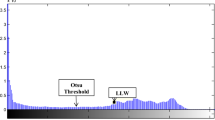Abstract
Breast cancer is the second main cause of death in women of western countries, so early detection and prevention is crucial. Early detection increases the likelihood of treatment as well as patient resistance. Among breast cancer detection methods, mammography is the most effective diagnostic method. For radiologists, diagnosing a cancerous mass on mammographic images is prone to error, which shows there is a need for a method to reduce the errors. In this study, a new adaptive thresholding method is proposed based on variable-sized windows. This method estimates the location of the mass and then determines the exact location of the cancerous tissue to reduce false positives. To detect the mass automatically, firstly, the histograms diagram and its relative maximums have been used to calculate the initial threshold for estimating the mass location. Two windows that contain information around each pixel and their size varies according to the mean value of each image due to the preservation of useful information. Secondly, two windows are used for the final threshold in order to discover the location of the mass and its exact shape. The proposed approach has been applied to 170 images of the Mammographic Image Analysis Society MiniMammographic database. Evaluations have shown 96.7% sensitivity and 0.79 false-positive rates, which prove an improvement in comparison with other state-of-the-art methods.








Similar content being viewed by others
Notes
Well-defined/circumscribed masses.
Calcification.
Spiculated masses.
Other, ill-defined masses.
Architectural distortion.
Asymmetry.
Contrast Limited Adaptive Histogram Equalization.
References
Anitha J, Peter JD, Pandian SI. A dual stage adaptive thresholding dusat for automatic mass detection in mammograms. Comput Methods Programs Biomed. 2017;138:93–104.
Ayres FJ, Rangayvan RM. Characterization of architectural distortion in mammograms. IEEE Eng Med Biol Mag. 2005;24(1):59–67.
Basha SS, Prasad KS. Automatic detection of breast cancer mass in mammograms using morphological operators and fuzzy c–means clustering. Journal of Theoretical & Applied Information Technology. 2009;5(6)
Cao A, Song Q, Yang X. Robust information clustering incorporating spatial information for breast mass detection in digitized mammograms. Comput Vis Image Underst. 2008;109(1):86–96.
Groshong BR, Kegelmeyer WP. Evaluation of a hough transform method for circumscribed lesion detection. Digital mammography. 1996;96:361–6.
Guliato D, Rangayyan RM, Carvalho JD, Santiago SA. Polygonal modeling of contours of breast tumors with the preservation of spicules. IEEE Trans Biomed Eng. 2008;55(1):14–20.
Kai Hu, Gao X, Li F. Detection of suspicious lesions by adaptive thresholding based on multiresolution analysis in mammograms. IEEE Trans Instrum Meas. 2011;60(2):462–72.
Jalalian A, Mashohor SB, Mahmud HR, Saripan MI, Ramli AR, Karasfi B. Computer aided detection diagnosis of breast cancer in mammography and ultrasound a review. Clin Imaging. 2013;37(3):420–6.
Karssemeijer N, te Brake GM. Detection of stellate distortions in mammograms. IEEE Transactions on Medical Imaging. 1996;15(5):611–9
Kekre HB, Sarode TK, Gharge SM. Tumor detection in mammography images using vector quantization technique. International Journal of Intelligent Information Technology Application. 2009;2(5):237–42.
Kobatake H, Murakami M, Takeo H, Nawano S. Computerized detection of malignant tumors on digital mammograms. IEEE Trans Med Imaging. 1999;18(5):369–78.
Kom G, Tiedeu A, Kom M. Automated detection of masses in mammograms by local adaptive thresholding. Comput Biol Med. 2007;37(1):37–48.
Kurt B, Nabiyev VV, Turhan K. A novel automatic suspicious mass regions identification using havrda & charvat entropy and otsu’s n thresholding. Comput Methods Programs Biomed. 2014;114(3):349–60.
Li H, Wang Y, Liu KR, Lo SC, Freedman MT. Computerized radiographic mass detection I lesion site selection by morphological enhancement and contextual segmentation. IEEE Trans Med Imaging. 2001;20(4):289–301.
Mencattini A, Salmeri M, Lojacono R, Frigerio M, Caselli F. Mammographic images enhancement and denoising for breast cancer detection using dyadic wavelet processing. IEEE Trans Instrum Meas. 2008;57(7):1422–30.
Farzaneh Moradkhani and Bahram Sadeghi Bigham. A new image mining approach for detecting micro-calcification in digital mammograms. Applied Artificial Intelligence. 2017;31(5–6):411–24.
Pereira DC, Ramos RP, Nascimento MZD. Segmentation and detection of breast cancer in mammograms combining wavelet analysis and genetic algorithm. Comput Methods Programs Biomed. 2014;114(1):88–101.
Wener Borges Sampaio, Edgar Moraes Diniz, Aristófanes Corrêa Silva, Anselmo Cardoso De Paiva, and Marcelo Gattass. Detection of masses in mammogram images using cnn, geostatistic functions and svm. Computers in Biology and Medicine. 2011;41(8):653–64
Singh S, Bovis K. An evaluation of contrast enhancement techniques for mammographic breast masses. IEEE Trans Inf Technol Biomed. 2005;9(1):109–19.
John Suckling, J Parker, D Dance, S Astley, I Hutt, C Boggis, I Ricketts, E Stamatakis, N Cerneaz, S Kok, et al. The mammographic image analysis society digital mammogram database. In Exerpta Medica. International Congress Series. 1994;375–8
Vikhe PS, Thool VR. Mass detection in mammographic images using wavelet processing and adaptive threshold technique. J Med Syst. 2016;40(4):82.
Zhang M, Giger ML, Vyborny CJ, Doi K. Mammographic texture analysis for the detection of speculated lesions. Excerpta Medica. 1996;1119:347–51.
Zhang XP, Desai MD. Segmentation of bright targets using wavelets and adaptive thresholding. IEEE Trans Image Process. 2001;10(7):1020–30.
Xiao-ping Zhang. Multiscale tumor detection and segmentation in mammograms. In Biomedical Imaging, 2002. Proceedings. 2002 IEEE International Symposium. 2002;213–6
Author information
Authors and Affiliations
Corresponding author
Ethics declarations
Conflict of interest
The authors declare that they have no known competing financial interests or personal relationships that could have appeared to influence the work reported in this paper.
Rights and permissions
About this article
Cite this article
Sadeghi, B., Karimi, M. & Mazaheri, S. Automatic suspicions lesions segmentation based on variable-size windows in mammography images. Health Technol. 11, 99–110 (2021). https://doi.org/10.1007/s12553-020-00506-6
Received:
Accepted:
Published:
Issue Date:
DOI: https://doi.org/10.1007/s12553-020-00506-6




